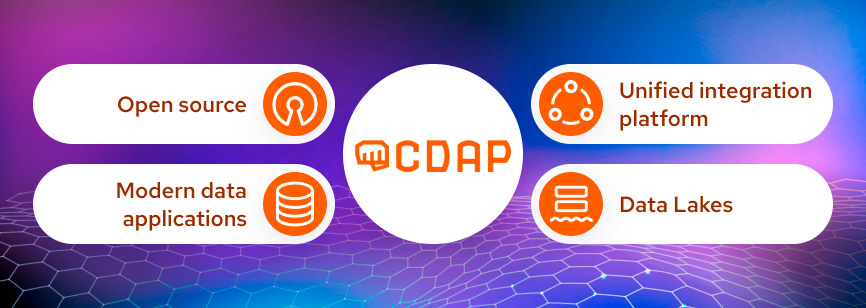
Significant competitive advantages are enjoyed by business operations that are equipped with tools that extract business intelligence from vast amounts of data. This capability can identify hidden business patterns, uncover paths to increased operational efficiency and enhance user experiences. Combining AI language models and big data technologies uncovers methods to improve complex processes.
The Cask Data Application Platform (CDAP) is designed to accomplish these goals.
What is the Cask Data Application Platform?

Cask Data Application Platform (CDAP) was created to develop, manage, and implement scalable and dependable big data analytics. CDAP offers developers a range of tools and APIs that facilitate the creation of sophisticated data processing systems in big data.
CDAP’ provides a container structure for storing data and applications within the Hadoop-distributed file system. Streamlined abstractions and thorough integration with various Hadoop technologies facilitate significant enhancements and efficiency in the engineering process and decrease time to market.
CDAP offers a robust GUI and extensive integration capabilities. CDAP’s easy-to-use APIs support a wide range of applications; from straightforward data analysis to enterprise and commercial data systems and structures.
CDAP container-based structure standardizes and encapsulates data and applications storage using HDFS, HBase, Spark, and MapReduce. Portability and reusability are made available by encapsulating data access patterns and business logic. Data normalization across storage systems and processing engines streamlines security, operations, and governance.
The Role of AI in Modern Data Applications
Artificial Intelligence (AI) has transformed the process of gathering, assessing, and utilizing data. AI data analytics leads to better decision-making, boosts operational efficiencies, and identifies new product and service opportunities.
Current AI models excel in collecting, storing, and normalizing data from multiple sources. Applied machine learning algorithms detect and rectify data anomalies, fill in missing values, and standardize data formatting, resulting in reliable data sets. Additionally, machine learning can be tuned to perform predictive analytics through analysis of historical data. Machine learning algorithms excel in identifying patterns and data overlaps to produce predictive analytics.
AI delivers a highly customizable user experience by analyzing user actions and preferences. Recommendation systems, which are fueled by artificial intelligence, offer tailored content, product suggestions, and promotional material to boost customer satisfaction and involvement.
AI & CDAP Integration
Maximize the effectiveness of data applications by combining CDAP’s data processing capabilities with AI’s advanced analytics and predictive capabilities. This combination uncovers a road map to creating smarter and more effective data pipelines that reveal deep business insights and guide toward more accurate business decisions. Important areas for integration:
Data ingestion and processing
AI’s machine learning algorithms detect and fix data irregularities, fill in missing values, and standardize data layouts. Methods such as isolation forests, local outlier factors, and autoencoders are utilized to identify and correct anomalies, ensuring the accuracy and dependability of the dataset. To preserve data integrity, imputation methods like K-Nearest Neighbors, Bayesian Networks, and Generative Adversarial Networks (GANs) are applied to fill in missing values intelligently.
Incorporating AI-driven cleansing methods into automated data pipelines using tools like Apache NiFi or Airflow guarantees ongoing and effective data quality control.
Predictive analytics
Using CDAP’s data pipelines to train and deploy models provides a standardized way to prepare and preprocess data for training AI models. Data pipelines perform data cleansing and conversion and create features for structuring data to be better suited for making strong AI models. Once the models are trained, they are easily implemented in CDAP for immediate real-time or batch predictions.
Automation
AI greatly improves CDAP workflows by automating repetitive tasks like labeling data, organizing, and creating reports. This functionality significantly improves data reliability, uniformity, and standardized management routines. In addition, AI is highly effective at improving system responsiveness and data reliability through smart alerts and monitoring. AI-driven notifications like Amazon CloudWatch Alarms are implemented to monitor the data flow and swiftly spot trends and irregularities. Conclusion: AI and CDAP integration improves workflows, data trustworthiness, and streamlined management of intricate data processing routines.
Personalization
Integrating AI models with CDAP applications greatly improves the user experience. AI models are tuned to identify and present personalized content or product suggestions by studying user behavior. For example, e-commerce websites can use algorithms to recommend products by analyzing a user’s browsing history and past purchases.
Additionally, businesses can use clustering algorithms to group customers based on their behavior and preferences. This segmentation enables targeted marketing strategies directed at the most relevant customer groups. For instance, a streaming platform can categorize users based on viewing behavior and likes, offering relevant suggestions and products that increase user engagement.
AI & CDAP Use Cases
Healthcare predictive analytics in patient care
Using AI to analyze patient history and forecast outbreaks, healthcare providers can offer more effective treatment through customized treatment plans.
Initially, CDAP pipelines collect data from electronic health records, wearable devices, and surveys. AI models sift through the collected data to spot irregularities, fill in missing information, and standardize data layouts. Then, machine learning algorithms such as logistic regression or gradient boosting are used to forecast the chances of readmission.
For instance, a hospital can decrease readmission rates with chronic conditions by using CDAP to collect and analyze data from electronic health records (EHRs), wearable devices, and patient questionnaires. AI algorithms examine this data to detect patterns and potential risk factors linked to readmissions.
Retail personalized recommendations
Combining AI with CDAP improves pricing strategies and the customer experience with targeted suggestions. By examining user behavior and market trends, retailers can adjust pricing and offer personalized product promotions in real-time.
For example, an online shopping website can boost sales and enhance customer satisfaction by utilizing CDAP to analyze customer interactions, purchase history, and competitor pricing.
The process starts with CDAP pipelines collecting data from multiple sources such as website interactions, purchase history, and competitor pricing APIs. Subsequently, this information is analyzed in real-time, enabling artificial intelligence models to identify patterns and trends. Reinforcement learning, among other machine learning algorithms, adjusts prices in real-time by considering factors such as demand, inventory, and competitor pricing.
Fraud Detection & Prevention
AI combined with CDAP can greatly improve fraud detection and prevention by analyzing real-time transactional data. Financial institutions can prevent fraudulent transactions and safeguard customers by spotting suspicious activities. CDAP is designed to process transactional data streams from different channels, like online banking, ATMs, and credit card transactions. AI algorithms examine this data to identify and stop fraudulent activities.
The process starts with CDAP pipelines collecting transactional data from online banking, ATMs, and credit card systems. AI models examine this data in real-time to detect irregularities and suspicious behavior. Machine learning techniques like isolation forests and neural networks are used to identify irregular transaction patterns that suggest fraudulent activity. When the system detects potentially fraudulent transactions, it alerts the bank’s anti-fraud team.
CyberVision AI & CDAP Integration Expertise
Cybervision provides professional services for CDAP, a robust framework with an Apache 2.0 license designed for creating big data and analytics applications.
Specifically designed for fast and simple data processing, it enables easy management and analysis of large amounts of data using Hadoop distributions like Hortonworks® Data Platform, MapR Converged Data Platform, and Cloudera Enterprise Data Hub.
A clean and reliable no-code CDAP environment allows businesses to effectively utilize their data lakes from multiple sources for valuable insights through visual data pipeline orchestration. The platform offers effective tools for speeding up, adjusting, and overseeing analytics solutions of different levels of complexity and size. It has recently been established as a key component of Google’s latest big data analytics offering - Google Cloud Data Fusion.
Business analysis and proof of concept
A critical component of CyberVision services is performing business analysis to understand the client’s process before integration. Next, we create a functional proof-of-concept (PoC) including essential integration of AI and CDAP elements required in the ultimate solution. This process ensures thorough project planning and visibility from start to finish.
Agile Delivery & Continuous Feedback
CyberVision utilizes an agile approach to provide immediate value from the start. We guarantee regular releases and ongoing client feedback analysis to achieve optimal outcomes.
Secure Cloud Migration
CyberVision offers comprehensive cloud migration services of applications and data to the cloud. Our committed specialists conduct precise, reliable, and safe migrations enabling businesses to take full advantage of AI and CDAP in a cloud environment.
Post-production support
After the solution is deployed CyberVision provides system support services, guaranteeing the AI and CDAP solutions operate continuously and reliably.
Conclusion
Combining AI with the Cask Data Application Platform (CDAP) transforms how companies handle and leverage their data. By utilizing AI, companies can automate intricate data processing routines, gain profound insights with predictive analytics, and make real-time decisions that boost innovation and efficiency.
The emergence of AI and CDAP offers advantages across industries like healthcare, retail, finance, and more. Data is precious. Combining AI with CDAP allows businesses to uncover gems hidden within the data leading to growth and a competitive business edge.

